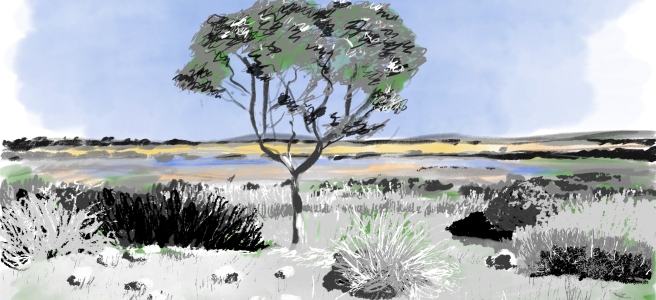Sketch of a hidden gem
The Bellarine Peninsula juts between Port Phillip Bay and wild Bass Strait like the knobbly head of a monstrous sperm whale, toothy jaws agape.
Our northern shores are nibbled by the choppy waves of Corio Bay and Outer Harbour; our southern beaches are thrashed by the big surf. In the jaws of the whale lies quiet Swan Bay. The chain of sand islands which almost close the mouth are the whale’s teeth.
Under the whale’s chin lies the fearsome Rip. All vessels that enter and leave Port Phillip Bay must run this gauntlet.
To drive down the spine of the Bellarine on either of the parallel highways, you’d think it a parched, droughty place in summer. The only standing fresh water visible is at Drysdale, with Lake Lorne and McLeod’s Waterholes, and a scatter of lakes down at Point Lonsdale, in the whale’s lower jaw.
Yet the Bellarine hides a vast, watery secret at its heart. Lake Connewarre is a 900-hectare wetland complex — not so much a single lake as a chain of lakes, wetlands and marshes. Through the reeds the Barwon River slowly threads, on its journey to the sea at picturesque Barwon Heads.
Connewarre is skirted by low hills which obscure it from view. Most of the shore is in private hands and difficult of access. There are but a few points where a traveller by car can catch even a glimpse of water.
In winter, the chilly, salt-laden south wind whistles in from Bass Strait; in summer, the reed beds are parched by hot northerlies under blue skies and a relentless scorching sun.
Connewarre seems a secret, desolate place now, but to the Wadawurrung people it would have been rich and productive, the heart of the Bellarine. Even today 149 bird species call Connewarre home for at least part of the year and 10,000 ducks and black swans may be found on its waters.
Inexhaustible hunting and fishing grounds were easily traversed by bark canoe. Great reed beds offered near limitless supplies of plant fibre to weave baskets and fish traps — and other light and durable possessions that made life comfortable. Diverse plant life gave food and medicine, while the rock pools of the adjacent coast offered vast bounty of seafood.
The Wadawurrung lived here for at least 40,000 years, and lived well. Their tenure of the land was already unimaginably ancient when they witnessed the creation of Port Phillip Bay 10,000 years ago. They will have seen the Barwon River change course and Connewarre fill — until the water carved its way through the barrier dunes to the sea.
Sketching notes

I drew the above sketch from photographs that I took on a bright, early spring day last year. I muted the colours for a grisaille effect to bring out the textures and the stark contrast of light and shade. The strong blues and greens of the original scene would have got in the way of what I wanted to express.
Adobe Fresco is a highly intuitive painting app for iPad. With an Apple Pencil and a matte film to give the slippery screen a little more grip, it feels quite like sketching on paper. It has the great advantage that you can draw light foreground textures first, then lay dark shadows behind them. As you can see, the effect is almost like a wax resist.
Here’s the photo I based my sketch on, for comparison. I always draw freehand from my originals, displaying the photo on my Mac and sketching on the iPad. It’s the next best thing to a plein air sketch. See what I mean about the colours?

I acknowledge the traditional custodians of this land, the Wadawurrung people of the Kulin nation, and pay my respects to their Elders, past, present and emerging.
Text and images © 2021 Steve Fendt. All rights reserved.


I kept wanting to highlight the text! I was paying attention to the way you insert pieces of information into the flow. They sit naturally and add to the story but I imagine it can be like a game of buckaroo, how many facts can you slip into a text before it falls apart (not that yours ever do).
LikeLiked by 1 person
Cheers Chris! Yeah, I know what you mean about the highlighting. It’s addictive 😊.
I like to write pieces that mix information and anecdote, as you know. I’m not always aware I’m doing it 😊!
LikeLike